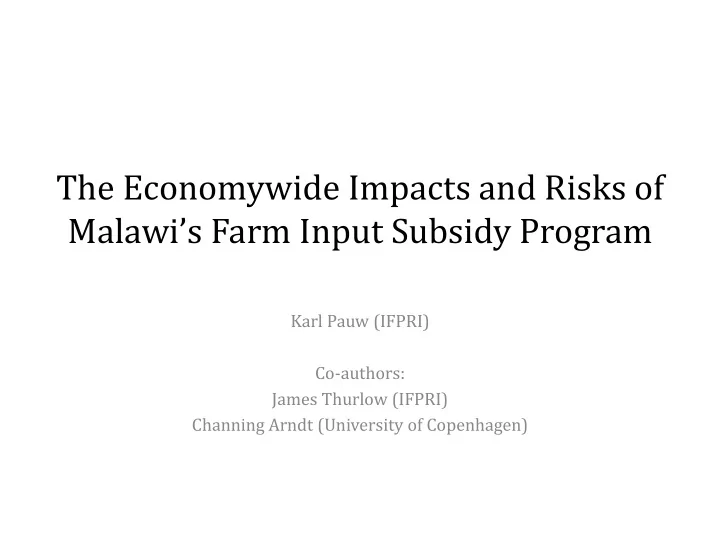

The Economywide Impacts and Risks of Malawi’s Farm Input Subsidy Program Karl Pauw (IFPRI) Co-authors: James Thurlow (IFPRI) Channing Arndt (University of Copenhagen)
Background and aim • Agricultural growth is a key driver of national GDP growth (6 − 7%) and (one would expect) poverty reduction • GAPP raises questions, but taken at face value the “official” outcomes are disappointing, especially considering the substantial investment the Farm Input Subsidy Program (FISP) • Two objectives: – Add a piece to the growth-poverty puzzle and the role of FISP – Contribute to the FISP evaluation literature by conducting an economywide assessment that identifies all impact pathways and spillover effects
Farm Input Subsidy Program • FISP implemented annually since 2005/06 – Widely targeted: 50% of smallholders – Generous: fertilizer and seed inputs provided more than satisfies a households’ annual maize demand; small voucher redemption fee – Costly: 3% of GDP; 70% of agricultural budget • Initially great deal of support (globally), but skepticism has grown: implementation issues; fiscal sustainability; policy alternatives; weather and price risk • Evidence: marginally positive to relatively high returns to the program in terms of national grain output and household income of beneficiaries ; implications for rest of the economy less clear
Modeling approach “Mixed-methods approach harnessing strengths of ex post evaluation data; triangulates this with information from other data sources; and addresses inherently ex ante design elements and risks in order to generate a comprehensive and unique method of program evaluation” CGE model base year 2003/04 (pre-FISP) includes the “traditional” • maize sectors but also negligibly small “FISP maize”, “FISP fertilizer”, and “FISP seed” sectors → program design elements and farm-level evaluations used to carefully construct the FISP sectors Replicate 2006/07 program by exogenously transferring 500,000ha • to “FISP maize” → once FISP operates at full scale, sector-specific technologies and program design elements exactly reflected Evaluate direct production effects, but also indirect effects associated • with price and income transmission effects, resource allocation, financing, and balance of payments shifts Additional simulations consider marginal returns to fertilizer use; • program scale; fertilizer price shocks; and weather variability
Simulation Design Maize Technologies (per hectare) Traditional FISP maize maize Composites Hybrids Fertilizer (50kg bags) 1.8 6.0 6.0 Local seeds (kg) 12.1 0 0 Improved seeds (kg) 8.3 20.0 15.0 Hired labor (days) 44.3 56.8 60.8 Maize yield (tons/hectare) 1.32 2.23 2.76 From fertilizer use 0.44 1.49 1.78 Base yield for seed variety 0.79 0.75 0.97 Marginal return to fertilizer use (kg grain/kg N) 15.0 18.0 60% of FISP seed was hybrid in 2006/07 → average 16.8kg grain per kg of nitrogen
Results Macroeconomic impacts Base value, Deviation from baseline 2003 Donor funded Tax funded Maize production (1000mt) 1,982.8 307.3 289.2 Maize land (1000ha) 1,501.9 -236.8 -248.9 Maize yield (average mt/ha) 1.32 0.49 0.49 Crop diversification index 0.613 0.036 0.040 Real maize price index (%) 100 -4.26 -3.15 Real exchange rate index (%) 100 -2.74 0.72 GDP market prices (%) 199.9 1.93 1.89 Absorption 226.0 3.89 2.07 Exports 51.2 -0.87 4.64 Imports 77.3 5.82 3.81 FISP benefit-cost ratio (BCR) - 1.62 1.62 Production-based BCR - 0.99 0.92 Total cost (mil. USD) - 65.9 67.2 Financed by foreign aid (%) - 100.0 16.4
Results Factor returns and poverty Base value, Deviation from baseline 2003 Donor funded Tax funded Average land return (%) 84.4 8.47 7.39 Average farm wage (%) 86.1 7.02 4.42 Poverty headcount rate (%) 52.4 -2.72 -1.78 Rural 55.9 -2.69 -1.82 Urban 25.4 -2.90 -1.45
Results Marginal return to fertilizer use and program efficiency Economywide BCR (production-based BCR) Marginal return to fertilizer use (kg grain/ kg N) 11.8 13.4 16.8 18.5 FISP benefit-cost ratio 0.78 1.06 1.62 1.90 Production-based BCR (0.49) (0.63) (0.92) (1.06)
Results Fertilizer price risks % change from baseline Real world fertilizer prices +0% +20% +50% FISP benefit-cost ratio 1.62 1.41 1.22 Production-based approach 0.92 0.49 0.07 Total costs (mil. USD) 67.2 82.3 105.3 Real exchange rate index 0.72 1.12 1.67 Tobacco production (1000t) 12.8 27.9 50.2 Poverty headcount -1.78 -1.37 -0.90 Rural -1.82 -1.42 -1.02 Urban -1.45 -0.98 -0.01
Simulation Design Weather Variability Loss Exceedance Curves 0 -5 Production loss (%) -10 -15 -20 -25 Local varieties -30 Composites -35 Hybrids -40 1 4 7 10 13 16 19 22 25 Drought return period (RP)
Results Weather Risks Economywide BCRs 3.0 Baseline-adjusted Hybrid 2.5 Actual FISP 2.0 Composite E-BCR 1.5 1.0 0.5 Unadjusted 0.0 1 4 7 10 13 16 19 22 25 Drought return period (RP)
Conclusions • FISP is reasonably pro-poor with potential to generate substantial indirect benefits – Indirect benefits are two-fifths of FISP’s total benefits – Economywide approach complements survey-based methods • BCRs depend strongly on marginal return to fertilizer use: – Drops below one with response rates from some survey studies – Crucial area of intervention; dealing with spending trade-offs • BCRs fall when real fertilizer prices rise (or exchange rate depreciates); macroeconomic constraints come into play • BCRs understandably fall during drought years; but FISP generates “double-dividends” of higher and more drought- resilient yields (hidden benefit)
Recommend
More recommend